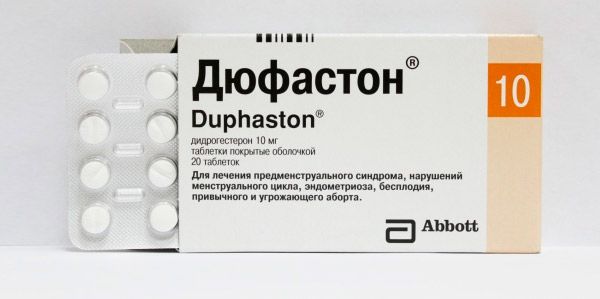Medical expert of the article
New publications
Preparations
Dyufaston with menopause
Last reviewed: 10.08.2022

All iLive content is medically reviewed or fact checked to ensure as much factual accuracy as possible.
We have strict sourcing guidelines and only link to reputable media sites, academic research institutions and, whenever possible, medically peer reviewed studies. Note that the numbers in parentheses ([1], [2], etc.) are clickable links to these studies.
If you feel that any of our content is inaccurate, out-of-date, or otherwise questionable, please select it and press Ctrl + Enter.

In the pharmacological group of hormonal drug-progestins, the drug Dufaston with menopause is prescribed both separately and as part of complex hormone replacement therapy, which consists in taking estrogen-containing drugs that help reduce the intensity of climacteric symptoms.
Indications of the duphaston with menopause
In the initial period of menopause - when the yellow body of the ovaries that produces the hormone progesterone ceases to form, and estrogen release occurs with short periods of increase in its level - indications for the use of Dufaston (Dydrogesteron, Dufaston, Dabroston, Duvaron, Gynorest, Terolut) include progesterone deficiency, hyperplasia of the endometrium (proliferation of the tissues of the inner shell of the uterus), multiple follicular cysts of the ovaries (polycystosis).
Duphaston with menopause and myoma of the uterus (fibromyoma) is prescribed only in cases when this benign formation is diagnosed against the background of pathologies such as endometriosis (heterotopic implantation of the endometrium, that is, its proliferation beyond the uterine cavity) or endometrial hyperplasia.
Pharmacodynamics
The active substance of the drug Dufaston dydrogesterone (6-dehydro-retroprogesterone) is an analogue of the endogenous female sex hormone progesterone and is an unacetylated derivative of pregnane of the class of retroprogesterones. The main action of dydrogesterone is anti-estrogenic, that is, neutralizing estrogen, which stimulates the mitotic activity of the cells of the tissues of the inner lining of the uterine cavity (which leads to endometrial hyperplasia).
Dydrogesterone selectively affects the membrane and intracellular receptors of estrogen (ER-A and ER-B) of the endometrium and reduce their sensitivity to this hormone, which leads to a decrease in mitosis cells. Also, Dufaston's drug interacts with the progesterone receptors (PR-A and PR-B) of the uterus during menopause, resulting in hormone-dependent processes in the tissues of the inner shell of the uterus normalized.
In all cases of endogenous progesterone deficiency, the therapeutic effect of dydrogesterone is closely related to its physiological effect on neuroendocrine control of ovarian function and on the endometrium.
Pharmacokinetics
After receiving Dufaston inside, it is absorbed into the digestive tract and enters the blood, within 0.5-2.5 hours, reaching the maximum concentration in the serum; binding of dydrogesterone with albumin of blood - up to 97%. Absolute bioavailability is 28%.
The cleavage of the active substance occurs in the liver - hydroxylation of cytochrome P450-dependent monooxygenases and binding to glucuronic acid.
Excretion of inactive metabolites from the body occurs through the kidneys (with urine); the half-life is 14-17 hours.
Contraindications
Use Duphaston in menopause is contraindicated if a woman has significant liver function disorders. This drug is not prescribed for hepatitis; hereditary pigmentary hepatoses; disorders of blood coagulability (including deep vein thrombosis and thrombophlebitis of superficial vessels of the limbs); severe cardiovascular insufficiency; violation of cerebral circulation; systemic lupus erythematosus; malignant neoplasms of the uterus or mammary glands.
Not appointed Duphaston with menopause and myoma of the uterus against the background of the unchanged state of the endometrium.
Interactions with other drugs
The drug interaction of Dufaston manifests itself in the fact that its effect may decrease with simultaneous oral administration of drugs that activate hepatic enzymes. This applies to alcohol-containing infusions, hypnotics of the barbiturate group, tranquilizers-benzodiazepines, antipsychotics from the group of aminazine and phenothiazine, and certain NSAIDs.
Shelf life
Shelf life of the drug is 5 years.
Opinion of doctors
The opinions of doctors regarding the advisability of using Dufaston in menopause - as well as the substitution hormone therapy itself at the beginning of menopause - diverge. First, the reception of hormones with their physiologically justified reduction is attributed to some gynecologists to attempts to change the course of age processes in the reproductive system of women inherent in nature itself. The tides that accompany the onset of menopause can be waited, but prolonged use of hormones can significantly increase the risk of thrombosis, stroke, and malignant processes in the mammary glands.
Use Duphaston with menopause and uterine fibroids some experts recommend - if simultaneously diagnosed with endometrial hyperplasia. Others adhere to the opposite point of view, referring to the pathogenesis of this pathology, in which activation of progesterone receptors of the uterine tissues plays a key role.
So while this issue continues to be in the study stage.
Attention!
To simplify the perception of information, this instruction for use of the drug "Dyufaston with menopause" translated and presented in a special form on the basis of the official instructions for medical use of the drug. Before use read the annotation that came directly to medicines.
Description provided for informational purposes and is not a guide to self-healing. The need for this drug, the purpose of the treatment regimen, methods and dose of the drug is determined solely by the attending physician. Self-medication is dangerous for your health.


 [
[